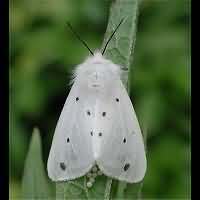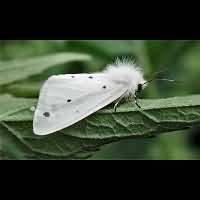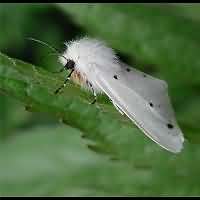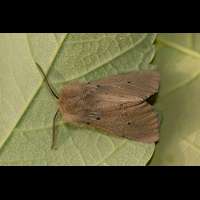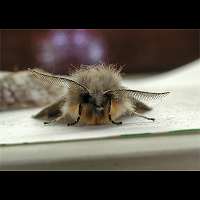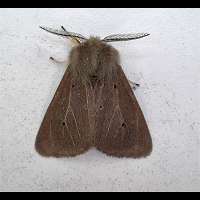Muslin Moth (Cycnia mendica)
The male and female of the Muslin Moth are very different indeed. The male is dullish brown with darker dots. The body and hairs are of the same dull brown colour. The typical Ermine shape of the Muslin Moth and their colour, unique among the Ermine and Tiger Moths make the male inmistakable. The female however is another story alltogether. She is white with a few blackish dots or spots. The body is white at first, but the secopnd half is whitish or yellowish white with black dots or lines. She can easily be confused with similar species: the Buff Ermine, the White Ermine and the Water Ermine. Compared to the Buff Ermine, the female Muslin Moth usually is whiter, the dots do not mark a line figure on the front wings and she lacks the orange colouring of the body. When comparing her to the very similar White Ermine look at the body: the female Muslin Moth has no orange patches there. The same applies when comparing her to the Water Ermine. Besides the Water Ermine has no spots on the hind wings; the female Muslin Moth has. Compared to all three of them, the Muslin Moth is on the wing earlier. Most white Ermine-like moths seen in April and May are Muslin Moths. The wingspan is highly variable: 30 to 43 mm.
The eggs are being laid in small groups and the first larvae appear even before mid-June. The caterpillar is greyish brown with yellowish brown long hairs. The head is light brown. It does look a lot like the caterpillar of the White Ermine, except for the dorsal line, which is usually missing, or if present, is very faint. The lines on the side are situated higher up on the body. The larvae of the Muslin Moth are capable crawlers as well. When they feel threatened, they roll up their body and pretend to be dead. Should the threat continue, they let themselves fall down if possible. But anyways they walk away very swiftly. They overwinter in a dark cocoon among leaflitter. The larvae can be found on herbaceous plants: dandelion, dock, chickweed etc. Reaching a length of around 3.5 centimeters the larvae remain rather small.
Even though regularly seen in June and July, the Muslin Moth is at its peak in May. The males fly by night exclusively and happily come to light. The females are sometimes seen flying about in daylight and they are rarely, if at all, attracted to light. Both can be seen in daylight resting on leaves, tree trunks or even walls. The Muslin Moth is more easily disturbed during the day than the White or Buff Ermine is. Especially females may suddenly fly off. Wide spread throughout England and Wales, rarer to the North, not in Northern Scotland. The same pattern applies on the continent. In certain areas a rather local species.
Usually the Muslin Moth is still referred to by its former scientific name Diaphora mendica.
The male and female of the Muslin Moth are very different indeed. The male is dullish brown with darker dots. The body and hairs are of the same dull brown colour. The typical Ermine shape of the Muslin Moth and their colour, unique among the Ermine and Tiger Moths make the male inmistakable. The female however is another story alltogether. She is white with a few blackish dots or spots. The body is white at first, but the secopnd half is whitish or yellowish white with black dots or lines. She can easily be confused with similar species: the Buff Ermine, the White Ermine and the Water Ermine. Compared to the Buff Ermine, the female Muslin Moth usually is whiter, the dots do not mark a line figure on the front wings and she lacks the orange colouring of the body. When comparing her to the very similar White Ermine look at the body: the female Muslin Moth has no orange patches there. The same applies when comparing her to the Water Ermine. Besides the Water Ermine has no spots on the hind wings; the female Muslin Moth has. Compared to all three of them, the Muslin Moth is on the wing earlier. Most white Ermine-like moths seen in April and May are Muslin Moths. The wingspan is highly variable: 30 to 43 mm.
The eggs are being laid in small groups and the first larvae appear even before mid-June. The caterpillar is greyish brown with yellowish brown long hairs. The head is light brown. It does look a lot like the caterpillar of the White Ermine, except for the dorsal line, which is usually missing, or if present, is very faint. The lines on the side are situated higher up on the body. The larvae of the Muslin Moth are capable crawlers as well. When they feel threatened, they roll up their body and pretend to be dead. Should the threat continue, they let themselves fall down if possible. But anyways they walk away very swiftly. They overwinter in a dark cocoon among leaflitter. The larvae can be found on herbaceous plants: dandelion, dock, chickweed etc. Reaching a length of around 3.5 centimeters the larvae remain rather small.
Even though regularly seen in June and July, the Muslin Moth is at its peak in May. The males fly by night exclusively and happily come to light. The females are sometimes seen flying about in daylight and they are rarely, if at all, attracted to light. Both can be seen in daylight resting on leaves, tree trunks or even walls. The Muslin Moth is more easily disturbed during the day than the White or Buff Ermine is. Especially females may suddenly fly off. Wide spread throughout England and Wales, rarer to the North, not in Northern Scotland. The same pattern applies on the continent. In certain areas a rather local species.
Usually the Muslin Moth is still referred to by its former scientific name Diaphora mendica.

